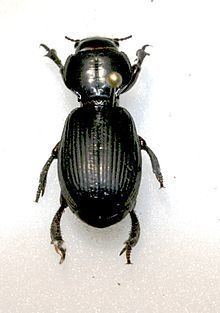Kingdom Animalia Suborder Adephaga Species B. antarctica Rank Genus | Class Insecta Family Carabidae Phylum Arthropoda Order Beetle | |
 | ||
Similar Beetle, Oregus, Mecodema | ||
Brullea antarctica is a carnivorous carabid beetle, the only species in its genus, that burrows in sand above the high tide mark on New Zealand beaches.
Contents
Description
Brullea antarctica is large (25 mm), shiny, and black, with a distinct "waist" or narrowing between thorax and abdomen, like the related genus Mecodema. Indeed, recent DNA analysis places it within that genus, a sister group to Mecodema curvidens; its distinctive differences in body shape may be adaptations to burrowing in sand.
Brullea's legs are well-adapted for digging, with expanded coxa, femur, and tibia: all tibia are greatly expanded at their distal ends, and the middle and hind pairs are also strongly curved. Brullea has short antennae, large curved mandibles, and a rather boxy shape in contrast to the longer more elegant Mecodema. Its larval form was unknown for some time, and was first described in 1978.
Distribution
Brullea is found in the supralittoral or splash zone of sandy beaches around the New Zealand coast, underneath logs or stones, hiding in the sand during the day and emerging at night to feed. It was described by Hudson as "usually rare", but is a secretive burrowing beetle, and occasionally is discovered in reasonable numbers. It was rediscovered by schoolchildren on the Whanganui coast in 2006 after not being recorded for many years.
Brullea antarctica has been recorded being heavily preyed on by katipo spiders, and it may be threatened by the introduced South African spider Steatoda capensis, either as a predator or competitor.
